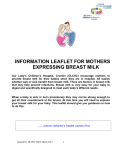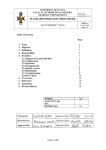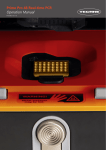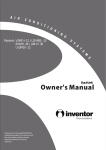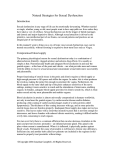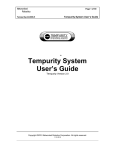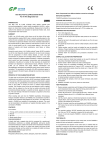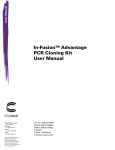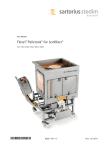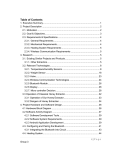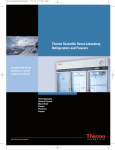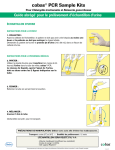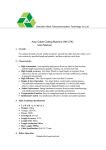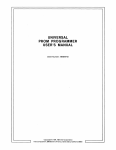Download AmniSure ROM Procedure
Transcript
POC.PC.17 Point of Care Testing AMNISURE® PROCEDURE FOR RUPTURED FETAL MEMBRANES TABLE OF CONTENTS 1.0 Principle of Procedure ……………………………………………………….. 2 2.0 Materials and Storage Requirements ……………………………………….. 2 3.0 Patient ID, Specimen ID and Specimen Labeling …………………………… 3 4.0 Patient Preparation And Specimen Collection …………………..................... 3 5.0 Procedure For Patient Testing ……………………………………………….. 4 6.0 Interpreting Test Results …………………………………………………….. 4 7.0 Reporting Test Results……………………………………………................... 5 8.0 Expected Values And Clinical Significance ……………………................... 5 9.0 Reference Range .……………………………………………………………... 5 10.0 Procedure Precautions and Limitations: Technical ……………………………………………………………… 5 Clinical ………………………………………………………………... 6 11.0 Interfering Substances ……………………………………………………….. 6 12.0 Quality Control Internal/External ………………………………………………. 6 Materials ……………………………………………… ……….. 7 Procedures ……........................................................................... 7 Interpretation …………………….. …………………………… 8 Protocol for unexpected results ……………………………….. 8 13.0 Calibration …………………………………………………………………… 8 14.0 Calculations ………………………………………………………………….. 8 15.0 References ……………………………………………………………………. 8 16.0 Electronic Linkage …………………………………………………………… 8 M:\Departments\Marketing\Webdata\POCNet Web on N Drive\procedures\AmniSureROMProcedure.doc Page 1 of 8 AMNISURE POC.PC.17 1.0 PRINCIPLE OF PROCEDURE: The AmniSure ROM test is a rapid, non-instrumented, qualitative test for the detection of amniotic fluid in vaginal secretions of pregnant patients who report signs, symptoms or complaints suggestive of rupture of membranes. Rupture of membranes (pPROM) prior to 37 weeks’ gestation complicates up to 12% of all pregnancies. 1 It uses the principle of immunochromatography to detect human PAMG-1 (placental a-1 microglobulin) protein present in amniotic fluid of pregnant women. Placental Microglobulin was selected as a marker of fetal membrane rupture due to its unique characteristics, i.e. its high level in the amniotic fluid, low level in blood, and extremely low background level in cervico-vaginal secretions when the fetal membranes are intact. The test does not require a speculum exam. A sample of fluid to be tested (collected by vaginal swab) is placed into a vial with solvent. The solvent extracts the sample from the swab for one minute, after which the swab is disposed. The AmniSure test strip, a lateral flow device, is then placed into the vial. The sample flows from the pad region of the strip to the Test Region. If PAMG-1 is present in the patient sample it will bind with antibodies in the test region producing a second line. The test result is indicated over the next 5-10 minutes. One line (Control) indicates no membranes are ruptured. Two lines indicate there is a rupture. This method is classified by the Clinical Laboratory Improvement Amendments of 1988 (CLIA’88) as a “moderately complex” test procedure (per FDA update 7/19/04). FDA approved the use of this test by Nurses and Midwives, as well as physicians. This test is used for definitive purposes. Certified Operators Are Required: Only authorized operators may perform AmniSure testing. Authorized operators are those individuals who have attended a training session and successfully demonstrated the skills required for testing. 2.0 MATERIALS AND STORAGE REQUIREMENTS: a. AmniSure ROM Kit in foil pouch with desiccant (FMRT-1-25 for 25 test kit; FMRT-1-10 for 10 test kit) Sterile polyester swab (supplied in kit) Plastic vial with solvent (supplied in kit; contains 0.9% sodium chloride, 0.01% triton x 100, 0.01 NaN3) Test strip (supplied in kit) b. Timer c. Sample Rack d. Store kits in dry location at room temperature 4-20 °C (40-68°F) e. Kits may be used until printed expiration date. f. Once Test Strip is removed from foil pouch, it must be used within 6 hours. M:\Departments\Marketing\Webdata\POCNet Web on N Drive\procedures\AmniSureROMProcedure.doc of 8 Page 2 AMNISURE POC.PC.17 3.0 PATIENT AND SPECIMEN ID AND SPECIMEN LABELING Patient Identification: Proper identification of the patient is essential for proper specimen collection. The patient’s name and ID# (account #, medical record #, DOB, or Soc Sec. #) must match the information on the patient’s ID bracelet. In situations where no ID bracelet exists, it is also acceptable for the patient to recite the above information to establish identity. Specimen ID and Specimen Labeling When specimen containers used for POC testing are removed from the patient’s presence in order to perform testing (i.e. taken outside the patient’s room or immediate area), the containers must be labeled in the presence of the patient (at bedside) and identified with the patient’s name and another unique identifier. However, in cases where POC testing is performed in the immediate area of the patient (within their presence), AND ALL of the following conditions exist, the container does not need to be labeled. The patient has been identified with two unique identifiers. Testing instrumentation is in the same room (area) as the patient. The specimen does not leave the testing personnel’s possession. The test results are being documented immediately. There is no other patient present. Note: Should the specimen container need to leave the possession of the testing personnel, for any reason, (even while the patient is present), it must be labeled with at least two unique patient identifiers. These guidelines are established in accordance with JCAHO Patient Safety Goals and CAP (College of American Pathologists) accreditation requirements. 4.0 PATIENT PREPARATION AND SPECIMEN COLLECTION: Note: Until the diagnosis of membrane rupture is excluded, avoid digital cervical examination to prevent infection and shorten the latency period. Establish Patient Identity Per Above MMC Policy Collect sample of vaginal secretions using the sterile swab provided in kit. Remove swab from packaging using care to not touch anything prior to insertion into vagina. Test strip remains in sealed pouch until just prior to use. With patient lying on back, hold swab in middle of stick and carefully insert polyester tip of swab into vagina until fingers contact the skin, no more than 2-3 inches (5-7 cm) deep. Withdraw the swab after 1 minute. Rinse swab in vial solvent for 1 minute by rotating swab, then dispose of swab. Test the patient sample as soon as possible after collection (See Section 7.0) If patient sample is not tested within 30 minutes and sample storage is necessary, tightly close the sample vial and place in refrigerator for no more than 6 hours. M:\Departments\Marketing\Webdata\POCNet Web on N Drive\procedures\AmniSureROMProcedure.doc of 8 Page 3 AMNISURE POC.PC.17 5. 0 PROCEDURE FOR PATIENT TESTING a. b. c. d. Open AmniSure kit, remove and label blue capped solvent vial with patient information. Give sharp tap to the vial to ensure all liquid in vial is at the bottom. Open the vial and place it into sponge rack to keep it vertical. Place the tip of the polyester swab containing patient sample (See Section 4.0) into the labeled vial and rinse in the solvent by rotating for 1 minute. e. e. Remove and dispose of the swab according to MMC standard precautions. Tear open foil pouch at the tear notches and remove AmniSure test strip. f. Dip white end of strip () into the correctly labeled vial of solvent. g Allow strip to remain in vial for 10 minutes, unless 2 lines are clearly visible. NOTE: Strong leakage of amniotic fluid will make results visible after 5 minutes, while a small leak may take up to 10 minutes. h i Read the results by placing the strip on a clean, dry flat surface. Do not read or interpret results after 15 minutes have passed since placing test strip into vial. Control Line Patient Test Line TEST STRIP FEATURES Pad Region 6.0 INTERPRETING RESULTS: There are 3 possible result interpretations POSITIVE: Both Control and Test Lines Present in Test Area THERE IS A RUPTURE NEGATIVE: Only Control Line Present in Test Area INVALID: No Control Line Present in Test Area NO MEMBRANE RUPTURE TEST POSITIVE TEST NEGATIVE INVALID TEST INVALID TEST M:\Departments\Marketing\Webdata\POCNet Web on N Drive\procedures\AmniSureROMProcedure.doc of 8 Page 4 AMNISURE POC.PC.17 Test Interpretation Notes: The darkness of the lines may vary. The test is valid even if the lines are faint or uneven. Do not try to interpret the test result based on the darkness of the line. 7.0 REPORTING RESULTS: 8.0 Patient Test and internal control results must be documented on Amnisure Result log sheet. In addition, the date and time of testing, operator’s initials and any other pertinent comments must be documented. Patient results are entered into the HIS by POCT Coordinator, or designee. AMA‘s CPT code® 84112 can be used to describe Amnisure ROM test.. EXPECTED VALUES AND CLINICAL SIGNIFICANCE: Leakage of amniotic fluid is indicative of the fetal membrane rupture in all women. Studies of placental a-1-microglobulin protein (PAMG-1) have established it as a marker of amniotic fluid. Concentration of PAMG-1 in cervical and vaginal secretions of pregnant women without complications in pregnancy was measured and is ranged from 0.05 to 0.22ng/ml. When vaginitis or non-significant admixture of blood is present, the background level of PAMG-1 can reach the maximum level of 3ng/ml. PAMG-1 concentrations in the amniotic fluid fall into the 2,000-25,000 ng/ml range. Clinically significant leakage of amniotic fluid increases PAMG-1 concentration in cervico-vaginal secretions by a factor of thousands. The sensitivity threshold of the AmniSure Test is set by a factor of 20 above the background level of PAMG-1 (AmniSure detects ~5 ng/ml of PAMG-1). 9.0 10.0 REFERENCE RANGE: Negative If No Rupture PROCEDURE PRECAUTIONS AND LIMITATIONS: A. Technical notes: Kit contents are for in vitro diagnostic use. Do not use kit contents after the expiration date printed on the outside of the kit. Do not use test strips if bent or damaged. Use appropriate precautions in the collection, handling, storage and disposal of the patient samples and used kit contents. Discard used materials in proper biohazard container. The test strip should remain sealed in foil pouch until just prior to use. It must be used within 6 hours. Proper testing protocol must be followed to obtain accurate results Each test is a single use disposable unit and cannot be reused Do not interpret results after 15 minutes have passed since placing test strip in vial M:\Departments\Marketing\Webdata\POCNet Web on N Drive\procedures\AmniSureROMProcedure.doc of 8 Page 5 AMNISURE POC.PC.17 B. Clinical notes: AmniSure test kit is for the in vitro detection of human amniotic fluid PAMG-1 protein in vaginal secretion of pregnant women. The test should be used to evaluate patients with clinical signs/symptoms suggestive of fetal membranes rupture. Results should always be used in conjunction with other clinical information. Until the diagnosis of membrane rupture is excluded, avoid digital cervical examination to prevent infection and shorten the latency period. This can lead to inaccurate results. Exclusion criteria include active vaginal bleeding from any source and placenta previa. Interrupted leakage with minimal residual fluid can lead to false negative result. The results obtained are qualitative and no quantitative interpretation should be made based on the results. Presence of significant blood on the swab can lead to a false positive result. The test functions properly in the presence of trace amounts of blood. In very rare cases, when a sample is taken 12 hours or later after a rupture, a false negative result may occur due to the obstruction of fetus or resealing of the amniotic sac. AmniSure should not be used earlier than 6 hours after the removal of any disinfectant solutions or medicines from the vagina. Women may labor spontaneously despite a negative test result. 11.0 INTERFERING SUBSTANCES Vaginal infections or urine do not interfere with the results of the AmniSure test. The performance of AmniSure has not been established in the presence of the following contaminants: meconium, anti-fungal creams or suppositories, K-Y Jelly, Baby Powder (Starch and Talc), Replens, and Baby Oil. Studies have shown that there is no interference of sperm factor in results. 12.0 QUALITY CONTROL (INTERNAL AND EXTERNAL): A. Internal Quality Control Protocol (performed with every test): AmniSure ROM strip contains a built-in reagent and procedural control to assure accurate reading of results. The Control line must be present or the patient test is invalid and must be repeated. Control results are documented on Amnisure Patient Result Log sheet. The appearance of the control line verifies the integrity of the test procedure. It assures that adequate sample volume was present and that adequate capillary migration (lateral flow) of the sample has occurred. The Control line also verifies proper assembly of the test strip by manufacturer. B. External Quality Control Protocol Prior to patient testing, external Positive and Negative controls must be run with random kits selected from each new shipment and/or Lot# of Amnisure ROM. This verifies reagent performance and acceptability of the new lot# for patient testing. External controls will also be run whenever there is suspicion that product performance is compromised or whenever kits have not been stored according to manufacturer instructions. The External Controls will be provided and performed by Point of Care Testing Coordinator, or M:\Departments\Marketing\Webdata\POCNet Web on N Drive\procedures\AmniSureROMProcedure.doc of 8 Page 6 AMNISURE POC.PC.17 designee. (1) Materials for External Quality Control Positive/Negative: a. External Positive (+) Control: Freeze-dried PAMG-1 protein is preferred (#PAMG-P0104B). Actual human amniotic fluid can also be used for a Positive control alternative. After collection the amniotic fluid is stored frozen in dry location at -18° to -12°C for up to 18 months. See procedure below. b. External Negative(-) Control: Amnisure Solvent Solution (2) Procedure For Positive External Control Using Pamg-1 Freeze-Dried Protein: NOTE: Since no human sample is collected, the Polyester vaginal swab should not be used to perform this procedure. Take a vial containing 10 ng of freeze-dried Human PAMG-1 protein found in Blue Blood Band Revco freezer (MMC #NC-0023) located in rear hallway. To this vial add the provided 1 ml of Amnisure Solvent Solution. Mix the solution well to ensure full reconstitution (e.g.vortex or shake vigorously). The solution from step #1 may be aliquotted into 5 separate vials (similar to the original vial) each containing 0.2 ml of the solution. This option allows 5 positive controls to be run from 1 vial of PAMG-1 protein. Use the solution from step #1 for Amnisure positive quality control by doing the following: 1). Dip the white end of test strip (marked ) into vial for exactly 10 min. 2). Remove test strip after exactly 10 minutes. Read the results by placing test strip on a clean, dry, flat surface. Do not read or interpret results if more than15 minutes have passed since dipping test strip into the vial. 3). Document control results on Amnisure QC log. (3) Procedure For Positive Control Using Human Amniotic Fluid: (Alternative Method if PAMG-1 not available) a. Using a test tube containing 0.1 ml of human amniotic fluid add 4.9 ml of saline. Mix for a few seconds. b. Take 0.50 ml of solution from step (a) and transfer to a 2nd small tube containing 1.5 of saline solution to obtain a 2.0 ml solution with minimal PAMG-1 concentration. Mix. (These proportions have been doubled to facilitate procedure). c. Transfer the solution to a vial similar to the vial supplied in the AmniSure test kit. 1). Dip the white end of the test strip (marked with ) into the vial with solvent for exactly 10 minutes. 2.). Remove the test strip after exactly 10 minutes. 3). Read results by placing the test strip on a clean, dry, flat surface. 4). Do not interpret results after 15 minutes have passed since dipping test strip into vial. M:\Departments\Marketing\Webdata\POCNet Web on N Drive\procedures\AmniSureROMProcedure.doc of 8 Page 7 AMNISURE POC.PC.17 Note: Dilutions can be stored at 4°-8°C for up to 24 hrs but immediate use is preferred. (4) Procedure For Negative External Control: Repeat the above steps (c. 1-4) using a vial similar to the vial supplied in Amnisure test kit. The Negative Control vial should contain saline, dH20 or actual test vial fluid. (5) Interpretation Of Quality Control Results: See section 6.0 C. Protocol For Unexpected Quality Control Results: Repeat testing on newly diluted positive QC or fresh tube of saline solution. Check operator technique, making sure proper timing is observed. Make sure test strips have not been stored improperly and are not bent. Makes sure expiration dates have not been exceeded. If expected results are not obtained, contact Point of Care at Ext.1795 or contact AmniSure Technical Service at 617-234-4441. 13.0 CALIBRATION: NA 14.0 CALCULATIONS: NA 15.0 REFERENCES: 1 Excerpt from “Technical Innovations in Clinical Obstetrics,” Joong Shin Park and Errol Norwitz. Contemporary OB/GYN, September 15, 2005, vol. 50. Cousins LM et al., “AmniSure Placental Alpha Microglobulin-1 Rapid Immunoassay versus Standard Diagnostic Methods for Detection of Rupture of Membranes”, American Journal of Perinatology, Volume 22, 2005. AmniSure ROM test package insert 5/17/2004 Manufacture-recommended QC Reference Sheet and Procedure Manual. 16.0 PROCEDURE ELECTRONIC LINKAGE NOTE: For document control this procedure is electronically linked to: M… Net, Nursing Services,Unit Specific, Maternal/Child in the Obstetrics section. M:\Departments\Marketing\Webdata\POCNet Web on N Drive\procedures\AmniSureROMProcedure.doc of 8 Page 8









